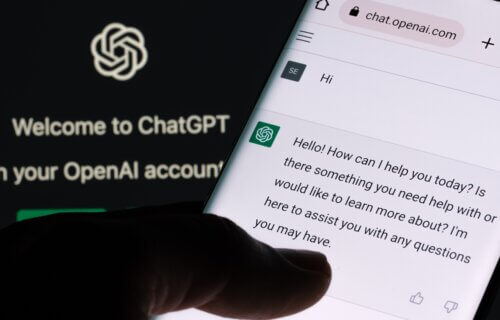TIV’ON, Israel — Could artificial intelligence be better at treating clinical depression than doctors? According to Israeli researchers from Oranim Academic College, ChatGPT may outperform human doctors in adhering to established treatment standards for clinical depression.
The study also highlights that AI like ChatGPT does not exhibit the gender or social class biases sometimes observed in the doctor-patient relationship.
Depression is a prevalent condition, with many individuals seeking assistance from their primary care physicians initially. Treatment recommendations for depression are typically guided by evidence-based clinical guidelines, which recommend a tiered approach to care based on the severity of the depression.
ChatGPT has the potential to provide rapid, data-derived insights that complement traditional diagnostic methods while ensuring confidentiality and anonymity. Given this potential, researchers sought to assess how well the AI technology evaluated recommended therapeutic approaches for mild and severe major depression, as well as whether these evaluations were influenced by gender or social class biases when compared to primary care doctors.
The study used carefully designed patient scenarios, called vignettes, that featured individuals exhibiting symptoms of sadness, sleep problems, and loss of appetite over the previous three weeks, with a diagnosis of mild to moderate depression. Eight versions of these vignettes were created, each with different patient characteristics such as gender, social class, and depression severity.
For each vignette, ChatGPT was asked, “What do you think a primary care physician should suggest in this situation?” The possible responses included watchful waiting, referral for psychotherapy, prescription of drugs for depression/anxiety/sleep problems, referral for psychotherapy plus prescription drugs, or none of these.

The results indicated that ChatGPT-3.5 and ChatGPT-4 recommended psychotherapy referral for mild cases in 95 percent and 97.5 percent of cases, respectively, compared to just over 4 percent of primary care doctors. In severe cases, ChatGPT recommended psychotherapy plus prescribed drugs in line with clinical guidelines more frequently than human doctors (72% for ChatGPT-3.5 and 100% for ChatGPT-4). Doctors more often proposed drug treatment exclusively.
When medication was recommended, both AI and human participants were asked which types of drugs they would prescribe. Researchers found that ChatGPT was more likely than doctors to recommend antidepressants exclusively, while doctors more frequently recommended a combination of antidepressants, anti-anxiety drugs, and sleeping pills.
Unlike some previous research findings, ChatGPT did not exhibit gender or social class biases in its recommended treatments.
Researchers acknowledged some limitations, including the study’s focus on specific iterations of ChatGPT and a representative sample of primary care doctors from France, which may not be widely applicable. Additionally, the scenarios described in the vignettes represented initial visits for depression complaints and did not account for ongoing treatment or other variables known to the treating physician.
The study suggests that ChatGPT has the potential to improve decision-making in primary health care. Ethical considerations, particularly data privacy and security, must be addressed when handling sensitive mental health data. AI should complement, not replace, human clinical judgment in diagnosing and treating depression, the researchers emphasize.
“The study suggests that ChatGPT…. has the potential to enhance decision making in primary health care,” says study authors Inbar Levkovich and Zohar Elyoseph in a media release. “However, it underlines the need for ongoing research to verify the dependability of its suggestions. Implementing such AI systems could bolster the quality and impartiality of mental health services.”
The study is published in the journal Family Medicine and Community Health.
How does ChatGPT work?
According to ChatGPT itself, the program is a language model based on the GPT-4 architecture developed by OpenAI. It is designed to understand and generate human-like responses in a conversational context. The underlying technology, GPT-4, is an advanced iteration of the GPT series and improves upon its predecessors in terms of scale and performance. Here’s an overview of how ChatGPT works:
- Pre-training: ChatGPT is pre-trained on a large body of text data from diverse sources like books, articles, and websites. During this phase, the model learns the structure and patterns in human language, such as grammar, syntax, semantics, and even some factual information. However, it is essential to note that the knowledge acquired during pre-training is limited to the information available in the training data, which has a cutoff date.
- Fine-tuning: After the pre-training phase, ChatGPT is fine-tuned using a narrower dataset, typically containing conversations or dialogue samples. This dataset may be generated with the help of human reviewers following specific guidelines. The fine-tuning process helps the model learn to generate more contextually relevant and coherent responses in a conversational setting.
- Transformer architecture: ChatGPT is based on the transformer architecture, which allows it to efficiently process and generate text. It uses self-attention mechanisms to weigh the importance of words in a given context and to capture long-range dependencies in language. This architecture enables the model to understand and generate complex and contextually appropriate responses.
- Tokenization: When a user inputs text, ChatGPT first tokenizes the text into smaller units called tokens. These tokens can represent characters, words, or subwords, depending on the language and tokenization strategy used. The model processes these tokens in parallel, allowing it to generate context-aware responses quickly.
- Decoding: After processing the input tokens and generating a context vector, ChatGPT decodes the output by generating a sequence of tokens that form the response. This is typically done using a greedy search, beam search, or other decoding strategies to select the most likely next token based on the model’s predictions.
- Interactive conversation: ChatGPT maintains a conversation history to keep track of the context during a dialogue. This history is fed back into the model during each interaction, enabling it to generate contextually coherent responses.
It’s important to note that the AI program actually admits that it has limitations, such as generating incorrect or nonsensical answers, being sensitive to input phrasing, being excessively verbose, or not asking clarifying questions for ambiguous queries. OpenAI adds that it continually works on improving these aspects and refining the model to make it more effective and safer for the public to use.


The irony is that this study is itself super depressing!
So, ChatGPT can’t figure out the cause of depression?
That is proof AI is ignorant, and worthless for depression.
NEWSFLASH…
Depression and anxiety are caused by heavy metals, almost always from mercury we receive from dentist’s fillings and doctor’s vaccinations.
Heavy metals disable immune system, too, so almost any disease can be the result.
The fix is to use Andrew Cutler Protocol (works great), and use bentonite clay drink once per day for one month, then take a 2 week break and repeat. Use 1/4 -1/2 teaspoon in 12oz water.
If you have candida fungus, which usually happens with mercury, depression, and anxiety, use combination herbal extracts that each contain multiple anti fungal herbs, and take them twice per week. They adapt quickly so alternate between two different products. The candida fungus will keep returning until mercury level has been reduced to manageable level for immune system. It worked great. Enjoy.